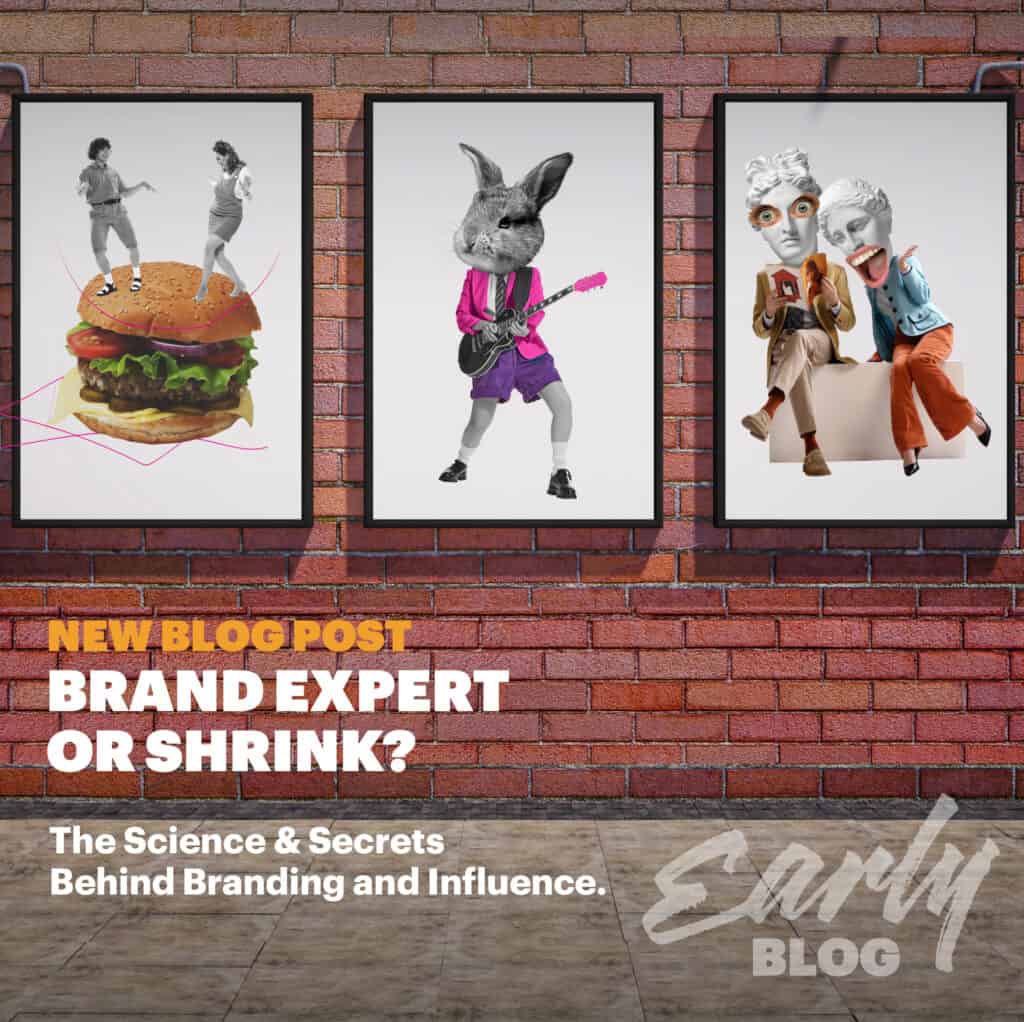Brand expert or shrink?
The Science, Psychology and Secrets of Branding

If you thought branding was all pretty pictures and fancy words, think again. The art of logos, colours and sexy phrases matter for sure, but there’s lots of clever science & psychology sitting behind these creative decisions that branding professionals like us use every day to entice, seduce and lock-in customer loyalty.
Here are the top ten neuroscience secrets every branding professional should know:
- Neural Engagement: Neuroimaging studies have shown that strong brands can increase neural engagement by up to 60%1 compared to weak or unfamiliar brands. Neural engagement happens when something strikes a relevant chord and creates pathways in the human brain. And nothing screams, “You want me”, more than your brand promising to solve a problem. This is why we work forensically at the start and throughout our client relationships on understanding what makes the audience tick, through research and data-driven insights that inform our creativity and storytelling. Our agency mantra: "Always fall in love with your customer problem, before you fall in love with your product or service."
1 Source: Martin Lindstrom, "Buyology: Truth and Lies About Why We Buy"
- Emotional Impact: Effective branding can lead to a 31% increase in emotional response2, which is a crucial factor in influencing consumer decisions. It’s a cliché to say that we buy with our hearts, but in terms of brand, no truer words have ever been spoken. Our work aims to have customers fall head over heels in love with our client’s brands. And once they're in love, it’s half the battle won in getting them to buy the products that solve their problem(s).
2 Source: Nielsen Consumer Neuroscience
- Memory Retention: Branding elements that are congruent with the content can improve memory retention by 89%3. Nobody enjoys that familiar let down of watching an ad, only to ask, “What the hell was that all about?” And how many times have you found yourself confusing one brand with another? So, think, what’s different, what’s unusual, exciting or unexpected, what could be truly memorable and stand-out about your brand? These are the questions we help Early clients answer every day.
3 Source: Journal of Neuroscience, Psychology, and Economics
- Neural Activation in Different Brain Areas: OK, let’s go real science nerd for the next few. Exposure to a well-branded logo can activate the brain's ventral striatum (associated with reward) by 10%, and the medial prefrontal cortex (associated with self-identity and personal relevance) by 5%4. That means that great branding actually makes us feel good! They give us a sense of value, a sense of ownership, and help to shape who we show up as.
4 Source: Journal of Marketing Research
- Visual Processing Speed: Brands we recognise are processed 20% faster5 in the brain's visual processing areas compared to unfamiliar brands. That’s not an excuse to spam the life out of your audience until you become memorable (our brains are also wired to reject inputs we perceive as threatening). Nor does it necessitate the need to spend millions projecting your logo onto the face of Big Ben! Creating familiarity comes in many different forms of marketing and creative strategy. Let’s just say for now, it’s critical to look, sound and feel different to your competition in an authentic way your audience will connect to and love.
5 Source: Various Scientific Reports
- Dopamine Release: Branding experiences that trigger a dopamine release can lead to a 20% increase6 in intent to purchase. Not only does dopamine make you feel good, in biochemistry terms it helps nerve cells send messages to each other. So, a happy brain, really is a receptive buying brain. In much of our campaign creative, and in some of the most unlikely of scenarios, we aim to elicit a smile, a chuckle, or an outright LOL. That’s often all it takes to release the happy juice.
6 Source: Neuron
- Preference and Decision-Making: Research has confirmed that the brain's preference centre (ventromedial prefrontal cortex) is more active when consumers interact with preferred brands, influencing decisions and leading to a 10-15% increase in purchase intent7. At Early, we aim to engage the brain in diverse ways along the customer journey. We first need to gain attention and engage, getting the synapses firing, ready for messages to land successfully and help in the consideration phase and decision-making process later on. We then deploy desired-action techniques to make the decision happen in favour of our client’s brands. Finally, we want customers to feel good about those decisions, to retain their loyalty, repeat business and promote brand advocacy. Good branding is a carefully crafted process, not a one-time event.
7 Source: Journal of Consumer Psychology
- Price Perception: Neuroeconomics studies have revealed that strong branding can influence the brain's valuation system, leading consumers to perceive a product's value as up to 30%8 higher. So that’s the pure bottom-line effect of influencing what happens inside our heads. But when price is in play, it’s deeper than that still. You need look no further than ‘own-brand’ discount retailers such as Aldi, to see how subtle and nuanced the psychological impact of branding actually is. They call themselves ‘own brand’ retailers when what they really are is ‘brand copycats’. Like the most famous masters of forgery, they know that were they to turn the colour palette for their version of Lurpak Butter green with pink spots, the illusion and warmth created by the original brand would be lost entirely.
8 Source: Journal of Marketing Research
- Trust and Brand Loyalty: Effective branding can increase trust and brand loyalty by up to 10%, driving repeat purchas and long-term customer relationships. In today’s world, customers actively seek brands they can trust, brands they feel are aligned with their own values, brands that are authentically on their side. Of course, a reliable product is critical as well, but it’s often an expertly crafted brand that gets them to trust, try, buy and come back for more.
9 Source: Psychology & Marketing
- Attention and Recall: Strong branding increases visual attention and recall by 13%10, contributing to better brand affinity. So, what is it that makes your customers notice, believe and act? Well, simply put, see all the above.
10 Source: Marketing Science
It's important to note that the impact of branding on the brain can vary based on factors such as individual differences or neurodiversity, cultural context, and the specific elements of branding being studied. The above provides a glimpse into some quantifiable effects of branding on the brain, highlighting how brand strategies can leverage neuroscience to create stronger connections with consumers. And this is what we do, day in, day out at Early (as well as creating the fancy pictures and sexy words).
About the author:
Neal Fullman is Co-founder and CEO of Early Marketing & Creative. He has worked with brands as diverse as O2, Sony, The FA, Tetley Teas, The International Tennis Federation, GetTaxi and Castlemaine lager, as well as multiple B2B brands looking to differentiate themselves and stand out from the competition.
To talk to us about using the science behind your brand to deliver unforgettable creative that improves commercial performance, feel free to give us a shout.

